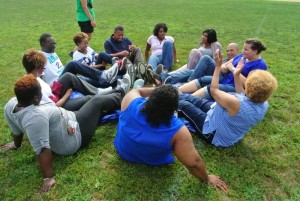
Terrapin Adventures specializes in creating customized corporate team building programs designed to meet the unique needs of organizations, like yours.
Seven researchers from the University of Central Florida and Army Research Institute set out to answer a very simple question – Does Team Building Work? It’s a question many business owners, managers, and decision makers have asked themselves over the years. Does it make sense to invest time and money into Corporate Team Building? Can one day of activities really make a measurable difference? According to research, the answer is a resounding Y-E-S! It’s no wonder that “team building is one of the most commonly applied group development interventions in organizations today,” according to researchers Deborah Diazgranados, Cameron Klein, Eduardo Salas, Huy Le, C. Burke, Rebecca Lyons, and Gerald Goodwin.
“It is widely used and comes in many forms, including outdoor experiential activities and indoor group process discussions.”
Does Corporate Team Building Work?
“Results (based on 60 correlations) suggest that team building has a positive moderate effect across all team outcomes,” write Diazgranados et al. Furthermore, according to researchers Barry Macy and Hiroaki Izumi2, who analyzed 131 studies of organizational change, “interventions with the largest effects upon financial measures of organizational performance were team-development interventions.”
Simply put, “Team developmental interventions are key mechanisms that may be used to facilitate team effectiveness,” writes Raymond Noe in Employee Training and Development3.
A Deeper Look at WHY Corporate Team Building Works
The aforementioned study, simply titled “Does Team Building Work,” looked at the impact of four specific team-building components: goal setting, interpersonal relations, problem solving, and role clarification.
- Goal Setting: By involving individual team members in goal planning, you further immerse them in the organization. As a result, they become more personally and emotionally invested in the success of the organization, which will cause them to work harder to achieve organizational goals.
- Interpersonal Relations: By strengthening interpersonal relationships, you strengthen trust and, thus, strengthen the team and the entire organization. “Organizations characterized by a high degree of trust are often the most successful,” according to Puget Sound Business Journal writer Maureen Moriarty. “When it comes to high-performing teams, I equate trust to someone’s willingness to be open, exposed and vulnerable.”
- Problem Solving: As they say, practice makes perfect. By tackling new problems and new ways of problem solving, you encourage your team to start looking outside the box and examining new and exciting ways to approach everyday challenges in the workplace.
- Role Clarification: Team building helps promote communication and collaboration and thus helps strengthen the chain of command. When your team begins to work together, productivity increases and thus profitability is maximized.
“The results are encouraging—they are suggestive of the idea that team building does improve team outcomes,” write Diazgranados et al. “Moreover, all the components (i.e., role clarification, goal setting, interpersonal relations, and problem solving) of team building had a moderate effect on outcomes but the goal-setting and role-clarification components had the largest effect.”
Experience the Power of Corporate Team Building for Yourself
Terrapin Adventures, conveniently located between Baltimore and Washington DC, specializes in creating customized corporate team building programs designed to meet the unique needs of organizations, like yours. Our experienced staff is able to design a program – onsite or offsite, indoor or outdoor –to help your group increase their ability to problem solve, think creatively and collaborate with one another.
Schedule Corporate Team Building Activities!
If you have any questions, please call Terrapin Adventure at 301.725.1313, or email us at info@terrapinadventures.com to learn more.
Works Cited
- Diazgranados, Deborah, Cameron Klein, Eduardo Salas, Huy Le, C. Burke, Rebecca Lyons, and Gerald Goodwin. “Does Team Building Work?” PsycEXTRA Dataset. Print.
- Macy, B. A., & Izumi, H. (1993). Organizational change, design and work innovation: A meta-analysis of 131 North American field experiments, 1961-1991. In W. Pasmore & R. Woodman (Eds.), Research in organizational change and development (pp. 235-313). Greenwich, CT: JAI
- Noe, R. A. (2002). Employee training and development (2nd ed.). Boston: McGraw-Hill.

Thank you for your research about this study. You give a great summarize. Those arguments prove my personal experience. But often enough I hear people say, that teambuilding activities are just an expensive waste of time. The points here add some good reasons to this kind of discussion.